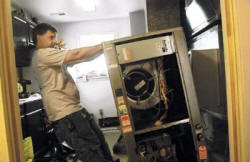Some Southern Maryland Workers Already Have ‘Green’ Jobs
Expansion called key to economic recovery in nation

Green’s all the rage.
President Barack Obama has pushed for “green technology,” “green energy” and “green” jobs as part of an economic stimulus package.
But what exactly is a “green” job?

There are many such positions right here in Southern Maryland: Heating and air-conditioning technicians who install geothermal systems in homes and businesses; electrical engineers and electricians who install solar panels; and plumbers who help connect energy-efficient wells and pumps to homes.
Jumping on the bandwagon for environmentally friendly technologies could not only position many laid-off new home construction workers to jump on a new boom, but could allow businesses to convert their focuses and find niches that accommodate current trends and new environmental regulations, local businesspeople and advocates say.
“We hear so much about green jobs these days but many don’t know what that means. These jobs already exist in Southern Maryland. It is our contention that many don’t realize that these are basic construction jobs,” said Pete Johnson, field organizer of the Maryland League of Conservation Voters Education Fund. “Clean energy jobs are both blue collar and white collar jobs — steel workers and engineers, electricians and designers.”
The federal Energy Independence and Security Act, signed into law in December 2007, authorizes $125 million annually for “green-collar” jobs training for positions such as engineers and hazardous materials cleanup, for example.
Clean energy technologies like wind, solar, geothermal and biofuels are among America’s fastest growing sectors and building and retrofitting for energy efficiency is another area of green job employment for an estimated 800,000 construction jobs if homeowners, school boards and businesses invest in renovating their buildings to become environmentally friendly, Johnson said.
Buildings are responsible for 48 percent of all greenhouse gas emissions annually, according to the U.S. Energy Information Administration. Seventy-six percent of all electricity generated by U.S. power plants goes to supply buildings.
Take Jim Deal of Huntingtown, who is a general contractor and electrician. After new home construction fell apart this year, Deal decided to convert his business focus to renewable and alternate energy for homes and businesses and is banking on public and private investment in such initiatives to pay the bills.
“Since new construction in Calvert County is gone, I decided that with the green energy solar and wind wave, they needed electricians,” he said. “I wanted to study what part of that I could get involved in and find a niche and bid on some work. It’s just a matter of time before the governments provide funding and grants so there’ll be more buying. Hopefully, that trickle-down effect will eventually reach me.”
“While there are many specialized lines of work that take special training and skills based on environmental knowledge, most green jobs are jobs American workers already do,” Johnson said.
For example, machinists and sheet metal workers construct and make parts for windmills and then truck drivers transport the parts.
“Currently, we import 70 percent of our windmills and parts. We could be making those here at home with blue-collar manufacturers who desperately need the work,” Johnson said.
Electrical engineer Richard Schmidt decided nearly 10 years ago he wanted to jump on new, environmentally friendly technologies, his daughter and employee, Shannon, said. He started Solar Tech Inc. in Hollywood and around 2003 the business focused on installing solar-powered electrical systems in homes and commercial properties. The company employs five people on a job, including master electricians and plumbers.
“He really wanted to do it because he wanted to do something better for the environment and not have to pay annually and monthly for an electric bill,” he said. “People are getting concerned about their electric rates rising. Most people are really concerned about the environment. They want to do something different.”
Schmidt said more interest in green products means a market will be created for new technologies that could be built into homes and energy benefits would actually make resale homes more marketable and valuable. Such a movement could help employ many more in green-collar jobs.
Great Mills resident Debbie Dunlap said her $20,000 investment in a geothermal heating and air system recently, which uses warmer temperatures underground in the winter and cooler temperatures underground in the summer to make heat pumps more efficient, is already paying off and she’s spending the hundreds of dollars she saves each month to purchase other things. She didn’t wait on state grant money, which had already run out for the year, to do so.
“I wish there was more out there to encourage people to invest; that’s good for the economy and lessens our dependence on foreign oil. I had no clue what geothermal was a year ago,” she said.
Dunlap said she called half a dozen contractors and found it wasn’t hard to find a servicer for the geothermal system. She considers herself and the contractors “green.”
“If you ask 10 people what a green job is you’ll get 10 different answers,” said Andy Moser, assistant secretary for workforce development in the Maryland State Department of Labor, Licensing and Regulation at a conference recently, emphasizing the need for the state and local counties to build things that are energy-efficient with environmentally friendly technology.
For some companies, going green is more about job and business retention, rather than finding a new niche or primary focus.
Chaney Enterprises, a concrete company based in Waldorf, recently introduced Drain-Crete, a type of concrete mix that allows water to pass through, in part to accommodate a new way of thinking about building among legislators.
The Storm Water Management Act of 2007 will take effect in 2009 with regulations that require developers to use practices that allow a certain amount of land to remain pervious, meaning that rainwater can penetrate through to the ground and prevent runoff, reduce stream channel erosion, pollution, siltation and sedimentation and local flooding. “It changes the way we look at stormwater management in new construction and modifications to existing sites. All of a sudden, the old way of doing things is the bottom of the list. We really feel that we’ve been laying the groundwork so we’re ready for when those regulations kick in,” said Steven Tripp, a Chaney spokesman. “As engineers start to work with the new regulations, it will really take off. For us green isn’t really job creation, it’s job retention. If we’re not moving this, we’re not going to be in the business very much longer. It is a full-on tidal wave now. You’re either surfing on top of the wave or under it. Green has got to be a part of the way we do things.”
“Green means renewable, plain and simple,” said Budd Gray, CEO of Bio-Mass Stoves in Callaway, which features stove models that allow home owners to heat their homes by burning wood pellets and other renewable sources. “Anything that’s renewable and reusable, low-carbon footprint and does not contribute to global warming is green.”
Gray said he is unsure of the number of people his industry employs but said it’s growing. In St. Mary’s County, he employs up to 12 people to help install the biomass stoves and perform service work.



